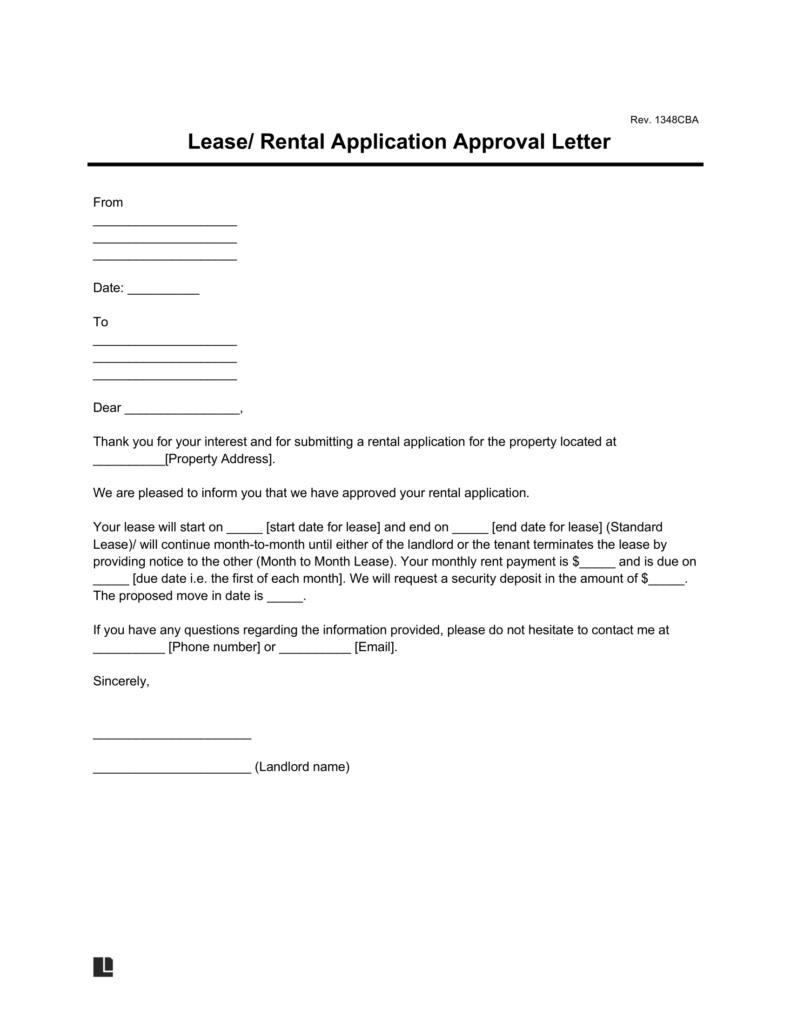
Use a rental application approval letter to formally welcome your chosen tenant.

Updated June 6, 2024
Written by Ioana Gagiuc | Reviewed by Susan Chai, Esq.
A rental application approval letter is a document issued by a landlord or property manager to inform a candidate that their application to rent a property has been approved. Typically sent after a thorough review and screening process, this letter serves as an official notification addressed to the tenant, providing critical information regarding the lease.
The letter includes the property address, lease start date and duration, rent amount and due date, security deposit details, and any other immediate steps the tenant must take.
When accepting a prospective tenant, it is crucial to determine if they meet specific criteria to guarantee a reliable and positive rental experience.
Following reference checks, credit checks, criminal records, and employment verification, look for indicators of financial responsibility, such as on-time bill payments reflected in a good credit score and stable employment history. Once you’re confident in their qualifications, here’s how to move forward with acceptance:
You should also send rejection letters to non-selected applicants and disclose if the rejection is based on a consumer report, as required by the Fair Credit Reporting Act.
Under the Fair Housing Act, you cannot base your decision on the applicant’s race, skin color, religion, national origin, sex (including gender identity and sexual orientation), familial status, or disability. Additionally, the U.S. Department of Housing and Urban Development has issued guidance indicating landlords cannot deny an applicant based solely on a criminal record.
Provide the sender’s full name and current address (the landlord or the rental property management company).
Write the date of the application approval letter.
Provide the recipient’s full name and current address, which is the applicant and prospective tenant.
Provide the complete street address of the rental property.
Write the lease term dates, amount of monthly rent, rent due date, amount of security deposit, and the proposed move-in date.
Provide the landlord’s phone number and email address.
The landlord will sign the approval letter.
A well-written rental application approval letter can serve several important purposes:

In leasing, an offer letter can refer to a few different documents. It could be a lease offer letter or an employment offer letter the applicant’s new employer provides to verify income.
A lease offer letter from a landlord to a prospective tenant, sometimes called an apartment rental offer letter if the property is an apartment, is distinct from a lease agreement and an application approval letter. It serves as a preliminary document indicating interest and outlining basic terms such as rent, security deposit, and lease term.
Prospective tenants may write offer letters as a starting point for negotiations, whereas landlords issue application approval letters to confirm acceptance of a tenant’s application.
Authorizing a tenant involves allowing them to undertake certain actions that may not be explicitly covered in the lease agreement. For example, if a tenant wishes to make permanent changes to the property or sublet a room, these requests are subject to the landlord’s discretion.
To authorize such actions, you should document your approval in writing through a lease amendment or supplement form to the lease agreement. Be as specific as possible to prevent misunderstandings and protect yourself in the event of a disagreement.
An offer to lease is a preliminary, non-binding document that outlines the basic terms and conditions under which a tenant might be interested in leasing a property. It serves as a starting point for negotiations. In contrast, a lease is a legally binding contract that details the finalized terms and conditions agreed upon by both the landlord and the tenant, making the arrangement official.
While lease offers are more common in commercial real estate, they can also be used in residential settings as an initial proposal before formalizing the arrangement with a lease agreement.